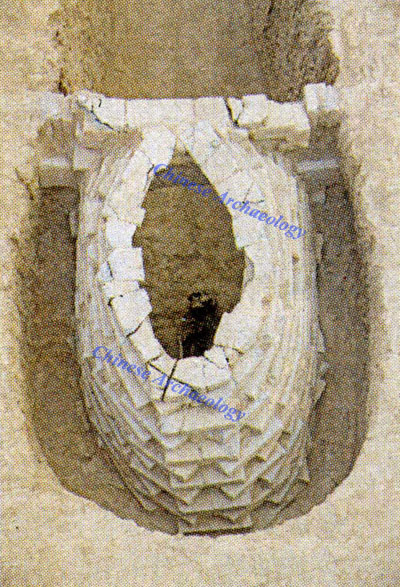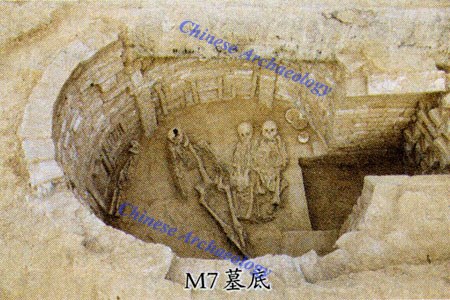Song and Yuan dynasty graves found in Zhaojiazhuang Cemetery, Shandong
From:Chinese Archaeology NetWriter:Date:2015-09-24
On March 4th 2015, Jinan City Archaeological Research Institute undertook investigation and excavation work in nearby Zhaojiazhuang Cemetery, Shandong province. In total, the research team discovered nine small-scale graves of various types: four round tombs with brick carving and wall painting; one boat-shaped tomb; four pit tombs with cave-chambers; and one earthen shaft tomb.Two of the round graves (M1 and M4) with brick carving and wall painting have survived in relatively good condition, and they resemble each other in structure. This structure includes four components: a tomb passage (a path leading to the grave); the gate to the burial chamber; a vaulted passage (a paved path leading to the burial chamber); and the burial chamber itself. The tomb passage is at the grave’s southern extreme and takes the form of a trapezoid shaft with vertical walls and a bottom section either flat or slightly sloped. The gate to the chamber is an imitation wooden structure, with the two edges and upper section formed of carved brick. The middle and lower sections have an arched door passage, and a sealed door with grey brick in the outer section forming a wall. The vaulted passage also has an arched roof. The pit of the grave is almost circular. Inside is a burial chamber made out of grey brick, with straight walls and a vaulted ceiling. Also inside is a coffin platform in the lower section. Some architectural features (e.g.brackets, houses, doors and windows) are recessed with grey brick into the chamber wall. Other recessed formations include furniture (such as tables and chairs, coat hangers and lamp bases), and some parts of the wall painted with murals. At Zhaojiazhuang Cemetery, this type of grave are all for joint burials for either two or four people, and a minority have coffins. Grave goods are sparse in all cases, mostly being porcelain bo bowls, pots and other bowls, as well as bronze coins etc.

the chamber of mural tomb M1
The boat-shaped tomb (M3) is made up of the same basic four components as M4. The tomb passage is orientated southwards and is shaft-shaped. The imitation wooden gateis relatively simple, but only remnants of the underpart of the door frame as well as the arched door passage have survived. The vaulted passage is quite short. The burial chamber is shaped like a boat, narrow at the front and wide at the rear and with both sides shaped like a bow. The two side walls gradually curve inwards from bottom to top, forming a small ovular opening at the top. At the bottom of the burial chamber there is one skeleton, but no signs of any burial equipment and no grave goods besides bronze coins.

the top of boat-shaped tomb M3
The structures of the three pit tombs with cave-chambers (M5, M6 and M8) are simple, consisting of a tomb passage, a tomb gate and a burial chamber. The passage is orientated southwards and is similar to a shaft. The gates are either earth-caves or imitation wooden structures, with a slab of stone or grey brick used to seal the respective entrances. The burial chamber’s lower section is either ovalular or almost circular, with a flat floor, bowed walls and a bowed ceiling. This kind of grave is for both single and joint burials: both types have burial equipment, but the grave goods are limited to just bronze coins and ceramic pots.
The earthen shaft tomb (M2) runs from northeast to southwest. Within the pit there is a burial chamber made out of stacked stones, with a passageway dividing the northern and southern parts of the chamber. In both sections is a coffin and one skeleton, although the southern part was robbed long ago. In the northern section, along the western wall there is a niche with one black glazed ceramic lamp and a ceramic pot. In the north section coffin there is also bronze coins. The lamp and pot have been identified as common to Qing dynasty graves, a dating supported by the presence of Qing coins (including from the Xianfeng era). Archaeologists thus believe the grave is from the late Qing period.
Circular graves with a brick chamber, boat-shaped graves and pit tombs with cave-chambers are all styles from the Song and Yuan dynasties common to the Jinan area. M1 contains Tang and Song bronze coins, as well as Jin period ingots, while the coins from other excavated tombs can all be dated to the Northern Song period. The recovered ceramic bo bowls and bowls from M1, M4 and M7 with an abdominal outer base and some scraped circles on the inside bottom were all popular in the late Jin period and the Yuan dynasty. Coupled with a white porcelain pot with two handles found in M6, archaeologists have preliminarily dated these graves to the Jin and Yuan dynasties. The other graves can generally be dated sometime from the Song to the Yuan dynasties.

the bottom of tomb M7

